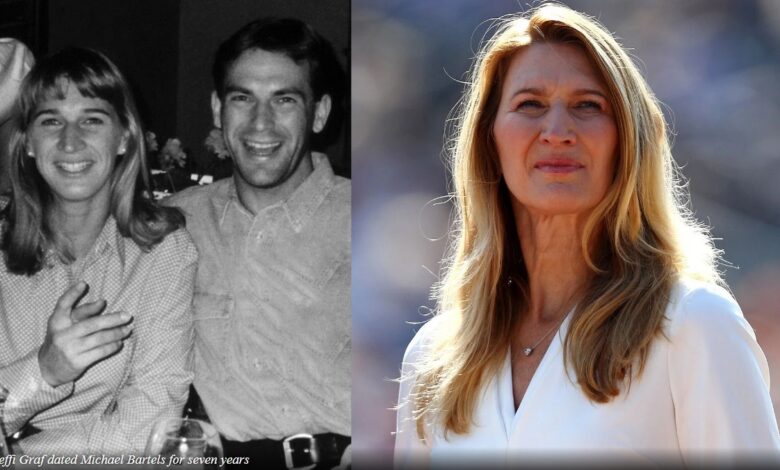“I don’t want to get into my private life too much” – When Steffi Graf politely refused to answer questions about her then-boyfriend Michael Bartels

Steffi Graf, the iconic German tennis champion, captivated the world with her powerful forehand and relentless determination on the court. Yet, her private life remained largely shrouded in mystery. This was particularly evident in her relationship with Michael Bartels, a German racing driver, whom she dated from 1992 to 1999.
When faced with persistent media inquiries about their romance, Graf’s signature response was a polite but firm, “I don’t want to get into my private life too much. ” This seemingly simple statement holds a significant weight, revealing the complex interplay between a public figure’s professional obligations and their right to privacy.
This essay delves into the context of Graf’s statement, analyzing the factors that shaped her approach to her personal life. We will explore the societal expectations placed upon athletes, the media’s insatiable appetite for celebrity gossip, and the psychological impact of living under constant public scrutiny.
Further, we will examine the concept of boundaries and how Graf’s stance serves as an example of setting healthy boundaries in the face of public intrusion. Finally, we will consider the broader implications of this situation, examining the ongoing struggle for privacy in the age of social media and the ever-blurring lines between public and private lives.
A Fortress of Focus: Protecting Performance
Throughout her career, Graf’s primary focus remained on achieving peak performance on the court. She was known for her laser-sharp concentration and her dedication to training. Any distractions, particularly those related to her personal life, could potentially disrupt her meticulous preparation and competitive edge. By deflecting questions about Bartels, Graf was essentially constructing a mental and emotional fortress around herself, shielding her inner world from external noise that might affect her game.
This approach wasn’t entirely self-serving. Tennis, like many professional sports, requires tremendous mental fortitude. Pressures to win, coupled with the constant evaluation and scrutiny by fans and media alike, can create a significant psychological burden on athletes. Maintaining a clear separation between professional and personal life can help athletes compartmentalize these pressures and prevent them from bleeding into their performance. Graf’s decision served as a protective measure, ensuring that her emotional energy remained focused on achieving her goals on the court.
The Fishbowl of Fame: When Privacy Becomes a Privilege
Athletes, particularly those who achieve a level of stardom like Graf, become unwitting participants in a social experiment where the lines between public and private life become increasingly blurred. Fans develop a sense of ownership over their idols, often feeling entitled to know every detail of their lives. The media, capitalizing on this insatiable public curiosity, relentlessly pursues any shred of private information, often resorting to intrusive tactics and sensationalized narratives.
Graf’s relationship with Bartels became a media feeding frenzy. Reporters saw a captivating story – the world’s number one tennis player linked to a dashing Formula One driver. Their inquiries extended beyond the realm of casual interest, often veering into speculations and unwarranted assumptions. By refusing to engage with these narratives, Graf asserted her right to control the information disseminated about her personal life. She understood that maintaining a degree of privacy was not a luxury but a necessity for her well-being.
The Art of the Boundary: Drawing the Line in the Sand
The concept of boundaries is central to healthy relationships, both personal and professional. Boundaries are essentially invisible lines that define our personal space, dictating what we allow others to access about ourselves emotionally, mentally, and physically. Setting boundaries is essential for self-preservation, enabling us to protect our energy and well-being from unwanted intrusions.
Graf’s polite but firm statement, “I don’t want to get into my private life too much,” exemplifies the art of setting a boundary. She communicated her discomfort with discussing a specific topic in a way that was respectful yet assertive. By doing so, she established a clear line between her public persona, the tennis champion, and her private life, the domain of Steffi Graf the individual.
The Ever-Evolving Landscape of Privacy
The Steffi Graf situation becomes even more relevant when viewed through the lens of the modern media landscape. With the rise of social media, the concept of privacy has undergone a dramatic shift. Celebrities are expected to maintain an active online presence, offering fans a glimpse into their personal lives. The lines between personal and professional personas are constantly blurring, creating a sense of oversaturation and a loss of control over self-representation.
However, Graf’s approach offers valuable lessons even in the digital age. Setting boundaries remains crucial, even on social media platforms. Athletes and celebrities, just like anyone else, are entitled to maintain a semblance of privacy. They can choose



